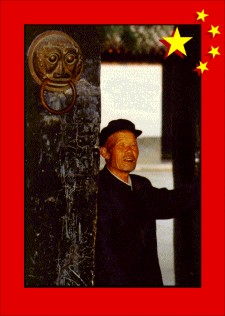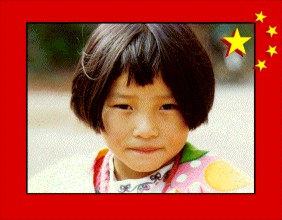[October, 1995] There is something alluring
about China. Something that gives China its luster. Something that makes
us intrigued by this home to such a large proportion of humanity. For those
of us who have studied about that mysterious land it continues to pull
us back no matter how hard we try to extract ourselves from its grasp.
China was the home of a great civilization that had as much influence in
Northeast Asia as Greece and Rome have had on the Western World. Hanzi,
or Chinese characters, are used to some degree in Vietnam, Korea, and Japan.
The thought of Kong Fuzi, or Confucius, has had a tremendous influence
on all these countries even to this day. The Buddhism that is practiced
in these countries is also a variant that was carried first through China.
It is because of this élan that we are always poised to see something
be reborn from the ashes of that once great place. It is with extreme difficulty
that we would ever realistically consider the fact that China's greatness
was at its pinnacle a millennium ago. That during the period known as the
Tang Dynasty, China was greater than it has ever since been. That since
this great dynasty, China has been ruled more by outsiders from Mongolia
and Manchuria than it has by Chinese. This century began with hope for
a new China that could possibly recreate the splendors that history heralded.
For the Chinese, both inside and outside of China, China is a place that
is held together by a history that is so rich, so impressive. Yet this
history also binds China to the dark ages thwarting valiant attempts to
democratize and modernize the country, and usher in a new era that would
otherwise eclipse the annals of Chinese history.
The several months before I travelled to China with my wife, Karen, relations
between the U.S. and China had plummeted - beginning sometime around the
visit of Taiwan's leader, Lee Teng-hui, to the U.S. relations were strained
but were on the mend when we arrived. China has unusual rules for granting
visas and we were able to obtain a dual entry visa that we eventually learned
meant we were only able to stay in China for sixty days: thirty days after
which we were required to exit the country for some time before we were
allowed to return for an additional thirty days. Our initial destination
was to Shanghai the contemporary magnet for foreign investment and the
home to a distant relation who had offered us a place to stay. When we
arrived, we learned that this relation was fearful of the Public Security
Bureau should they learn that foreigners were staying at her house without
official permission and so she had prudently withdrew her invitation. Discouraged
that our stay in China would be much briefer out of financial necessity,
Karen agreed with me to spend a month travelling through the country before
our first visa expired, and so we began our journey to Nanjing, Zhengjiang,
Yangzhou, Tai'an, Qufu, and Beijing.


Despite China's ancient historical legacy, Shanghai like Hong Kong became
a great city only after the Western powers took it and exploited it for
their own use. It is because of the history of that city in the several
decades before the communist regime came to power that the advanced industrialized
nations are once again focusing investment on this city.
Trying to be nonchalant as I peered in windows while I walked down Yang
Chang lu (street) in the direction of the Bund, I saw a traditional
China that appeared to have changed little in centuries bestride signs
of a country entering the technological age of the 20th Century. In one
household I saw a child using a computer as the small family looked on,
and as I walked further along I saw other households with computers, but
no apparent signs of a different sort of luxury, electric fans. Homes extended
out onto the curbs of the streets either because their dining rooms were
just on the other side of an open window or door that was only a few feet
from the street or because the curb is their only real front yard. The
Shanghainese sat on foot-high stools, talked, attended to kitchen
chores, or had a bite to eat on these sidewalks as if this area was the
natural extension of their home, impervious to pedestrians walking by them.
The most distinguishable Chinese fashion that we observed in Shanghai
was stocking wear. The sheer stockings which women, and not a few men,
wore were a yellowish color that couldn't have been more unattractive except
for the fact that the nylons had typically fallen down one of the legs
of the women who were visibly wearing these "knee-highs". Had I grown up
in impoverished China, it probably would not have seen so bizarre to me
that men could be seen wearing these nylons with tennis shoes and women
wearing men's style silk socks.
As I turned a corner to walk through a market area, I was surprised
to see the vendors typically used hand operated scales to determine prices
for produce and meat. At a busy intersections policemen were practicing
a conservation of sorts. They had emblems still in the store-bought protective
plastic pinned to their right shoulder. Later, on a rainy day, I surmised
that these were portable patches the policemen put on the shoulder of rain
gear or jackets whenever such protective gear is needed. I turned another
corner to see an illustration and the Chinese characters for a public telephone
just above an outdoor cement countertop where five phones rested. An attendant
looked over the phones while people talked on them without the partitions
providing privacy most non-Chinese are so used to. A few feet away the
scene took on a sharp contrast where a man was talking on a cellular phone.
Even in this once most foreign of Chinese cities most people stared
at me, some eager to smile if I did, others looking with suspicion and
wonderment. I thought of an autobiography I had read once of an ordinary
Chinese women who had seen the end of the nineteenth and beginning of the
twentieth centuries. She explained how the first time she had seen a Caucasian
she screamed and ran because the pale white skin, long nose, and sunken
eyes had looked so frightening to her. Luckily for me, it wasn't the first
time the people I encountered had seen a Caucasian, but I was an oddity
nevertheless. A lot of people would say "hello" just to hear my response.
Everybody seemed surprised at anything I took pictures of just as Americans
used to be when Japanese businessmen toured through the U.S. in the 1970s
taking pictures of what looked to us as the most mundane objects. On a
couple occasions someone would alert a small group playing cards or looking
at something for sale that I had stopped to observe the activity they were
engaged in. I was lucky that these people didn't react as if I was intruding,
but I'm sure this is only because that were a little bit intrigued by a
large-nosed, blond foreigner.
Looking for protection from the rain at one point we walked through
a small, covered "wet-market" where we saw dried fish, live turtles in
buckets, heaps of frogs in another relatively small bucket, fish, crabs,
prawns of different sizes (some were at least five inches long and fat),
slugs, large black plastic jars filled with some sort of sea life (we couldn't
tell if it was meat or vegetables), and buckets with both live and long
dead eels. It was a rather typical "wet market" of East Asia but seemed
dirtier to me. In contrast to this market and the areas in Hong Kong where
we saw animals being butchered, the butchers in Shanghai that were visible
from the sidewalks seemed to have at least a semblance of concern with
sanitation in their work. They often worked behind glass encased store
fronts, and wore white clothing, including head coverings which were sometimes
accompanied with masks.
The highlight of our day was when a man, probably a minority from a
mountainous region of Western China, showed us a tiger paw that had tendons
sticking out from where it had been cut-off. He asked us if we wanted to
buy it. I said "no," but motioned that I would like to take a picture of
him with it for 2 Yuan. He declined.
From the Bund we took a bus home for 1 Yuan each (about
12 cents). We rode on two busses this day, one was an articulated bus with
hard, individual wood seats on each side and more than twice as much space
for people to stand which, when crowded with people, gave it the impression
of a cattle car. The floor was wooden, and in addition to the driver there
were two seated conductors-one in the front and one in the back who sold
tickets, operated the doors, and signalled for the driver to start up.
The second bus was smaller and had padded seats with bamboo (or some similar
material) slat coverings, and a wooden floor. In the newly built up areas
there were busses with coin collection boxes next to the driver instead
of conductors just as in Western countries.


Nanjing, the "Southern Capital" and site of the infamous "Nanjing Massacre"
during World War II, is commercially dwarfed by Shanghai. Nanjing was the
capital of China for a brief time when the Ming Dynasty was first established
and much of the impressive walls surrounding the city which date from this
period can still be seen.
One of the most important and impressive Chinese monuments of this century
is that which honors Sun Yatsen in Nanjing. Perhaps it is fitting that
this monument is to the man most widely respected for his achievements
on behalf of the Chinese people this century. Where other countries may
have had greater resources to build a more lavish monument, the design
of the Sun Yatsen monument in Nanjing could not have achieved more. Taking
advantage of the terrain of the area, the monument is built on a hill top.
A visitor enters a large gate before ascending hundreds of stairs that
requires enough physical exertion to allow for little else than for you
to focus on the goal of your hike, a mausoleum complex at the top of the
stairs. Inside the first chamber of the mausoleum there is a prostrate,
larger than life-white statue of Sun Yatsen which appears to gaze out over
the picturesque valley below. Indeed there should be a sign at the bottom
of the hill advising visitors not to look back until they have ascended
the stairs to the top, to the mausoleum. The simple, but somehow ideal,
domed chamber of the inner chamber lies at the furthest point from the
gate down below and houses a white, reclining statue of the hero which
is suppose to rest atop the tomb of Sun Yatsen. It is suspected that the
tomb itself is empty, that his body was taken to Taiwan by the Guomindang
long ago.

